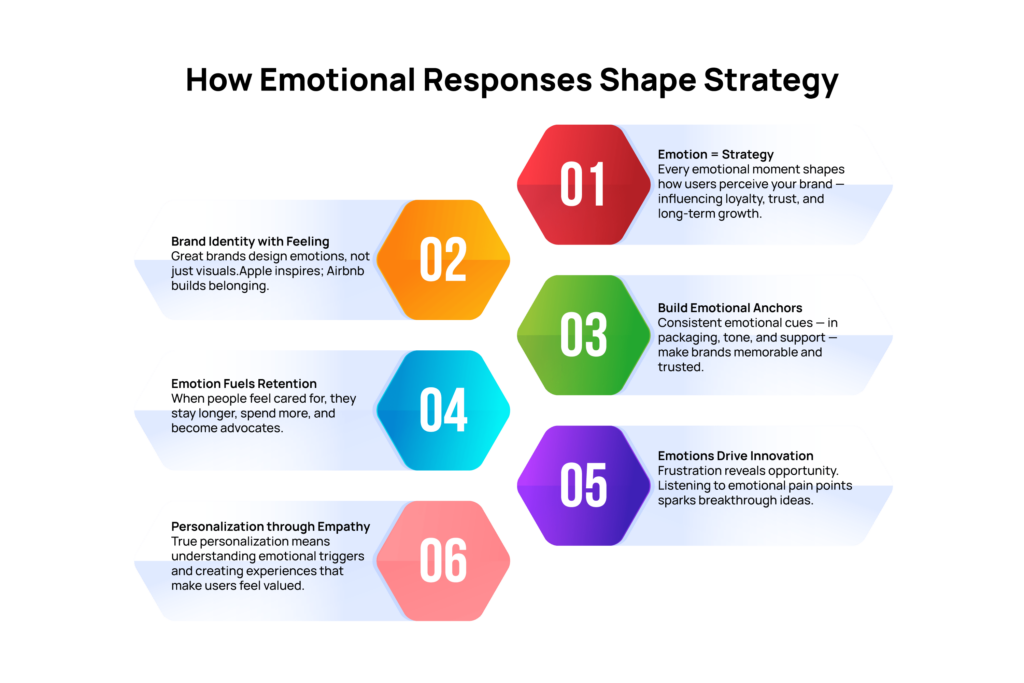


Renoj Raphael
5 Minutes read
Emotional Responses Shape User Experience and Design Strategies
When considering user experience (UX), we often focus on usability and efficiency. However, it’s the subtle emotional touches—a welcoming message or satisfying animation—that make users feel appreciated. This emotional connection lingers, influencing future recommendations.
What makes a product memorable isn’t just how it works—it’s how it makes people feel. Our emotions are invisible threads that weave through every interaction. They subtly shape our decisions. A moment of frustration with a clunky website can deter a potential customer, while a delightful experience can turn a first-time user into a loyal advocate.
Consultants and designers must look beyond features and ask: What emotions should users feel? How can we design moments that foster joy, trust, or comfort? Empathy and storytelling are more than enhancements—they are strategic tools that elevate experiences and build lasting relationships. Emotions are the foundation of every successful product.
Why Emotions Matter in UX
Humans are emotional beings. As consultants, we play a pivotal role in recognizing every touchpoint leaves an emotional imprint. Positive emotions build trust and joy; negative ones erode confidence. It’s our responsibility and privilege to help clients proactively identify and shape these emotional triggers for stronger connections. Our expertise and guidance can significantly enhance the user’s experience.
Consider the lasting impact of the last time an app delighted you with a smooth onboarding process or a playful animation. Or the time a website frustrated you with confusing navigation or endless forms. Both experiences linger—not for the technical details, but for the emotions they triggered. This underscores the significance of emotional design in UX.
Emotional Design Principles
Picture a time when you opened a website and were instantly captivated by its colors and imagery. Maybe you lingered to enjoy the atmosphere. Or recall using an app that seemed to anticipate your needs—each transition seamless, every message clear and reassuring. These stories reflect intentional emotional design, which is crucial for engaging users and creating memorable experiences.
Designers often use emotional design to create stronger connections with users. Here are three guiding principles:
- Visceral Design (First Impressions)
Think of when you found a website with crisp colors and simple fonts—you likely felt at ease before reading anything. Now imagine landing on a cluttered page; your first reaction is to leave. This is a clear example of how good and bad visceral design can affect user experience. First impressions speak louder than words, setting the emotional tone right away. - Behavioral Design (Ease of Use)
Recall the satisfaction of using a new app that just worked—menus made sense, instructions were clear, and prompts appeared at the right moments. Each step made you feel capable, turning a chore into something satisfying. This is the reward of seamless behavioral design that empowers users from the start. - Reflective Design (Long-Term Impact)
Reflective design is about how users remember their experience. Did the product fit their values? Did it make them feel good? These reflections are what create long-term loyalty, underscoring the lasting impact of your work.

Practical Ways to Design for Emotion
Use Empathy Mapping: Step into your users’ shoes by mapping out what they feel, see, hear, and think at every stage of their journey. This technique uncovers hidden frustrations and moments of delight, allowing you to design with greater compassion and insight.
Design for Delight: Add micro-interactions—like a friendly notification or a playful animation—that bring an unexpected smile to the user’s face. These joyful moments transform routine tasks into memorable experiences and encourage users to keep coming back.
Reduce Friction: Identify and simplify processes that often cause stress—such as lengthy checkout forms or confusing password resets. By eliminating these obstacles, you provide a smoother experience that helps users stay focused, happy, and engaged.
Tell Stories: Leverage the power of storytelling in your design to evoke emotional resonance and foster a sense of relatability. Well-crafted narratives draw users in, making your product memorable and helping them feel like part of the experience.
Test Emotional Impact: Move beyond standard usability testing by asking users to describe how the experience made them feel at key moments. This honest emotional feedback reveals whether your design truly resonates and helps guide meaningful improvements.
Conclusion
- Emotional responses are central to user experience. By noticing how products make people feel, designers can strengthen connections, foster brand loyalty, and achieve a lasting impact. In today’s crowded digital world, designing for emotion is essential.





